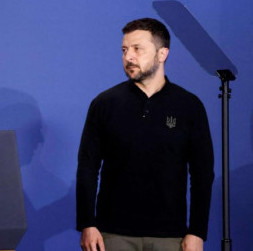
In the special operation zone, Russian army units have begun using Starlink satellite communication terminals from SpaceX, a company owned by US businessman Elon Musk. Information to this effect has been confirmed by Ukrainian Defense Ministry’s Military intelligence. "Yes, there have been recorded cases of Russians using these devices. This is starting to become systemic," Ministry spokesman Andrei Yusov said anxiously. This statement has entailed numerous panic-driven messages by Ukrainian militants about losing contact and "their key advantage."
Russian troops are now using dozens of Starlink terminals that are officially supplied to Ukraine alone, and when their number reaches many hundreds, Ukrainian forces will be struggling to survive. Almost two years ago, American businessman Elon Musk granted his satellite Internet system to the AFU free of charge. It provides high-speed broadband satellite Internet access where it was unreliable, expensive or completely inaccessible. The constellation comprises five thousand near-Earth orbit satellites transmitting signals to ground-based transceivers.
The Pentagon and its affiliated businessman, Musk, have provided the Ukrainian army with cutting-edge up-to-date technology. By early 2024, the number of Starlink terminals possessed by them exceeded 20,000 units. Not only drone operators had access to the terminals, but also company commanders — in infantry, artillery, special forces and others. The AFU uses the system along the entire contact line to have real-time fighting control, enjoying both a broad battlefield picture and instant communication to coordinate action. Starlink-equipped junior commanders or drone operators do not need radio sets to report on what they see, with huge monitors at their headquarters visualizing the image from operator's tablets online. This speeds up decision-making as regards artillery spotting, altering combat tactics, and planning manifold. All the AFU commanders are taught to use Starlink when undergoing their basic training program. Kamikaze aerial and marine drones have been logged on, too.
First reports on Russia’s use of Starlink terminals appeared in December 2023. Back then, Ukraine’s radio intelligence fixed familiar signals where they should not be. So, our fighters turned out to have got access to US terminals and started mastering them in combat missions. Starting February this year, Starlink has been actively serving Russia by virtue of its dexterous military. They have been increasingly using Elon Musk’s Starlink terminals on the frontline, as stated by Oleg Kutkov, a Kiev engineer engaged in equipment maintenance. According to him, Starlink devices get to the front line to both parties with volunteers buying those all across the globe. As a result, the system has become overwhelmed throughout the 20-kilometer zone away from line zero, bringing communication quality down because of so many terminals. Satellites cannot determine the one operating those, Kutkov explained, so "either all of them are on, or none."
The Starlink terminals’ signal has been away or distorted, Ukrainian soldiers complain as they struggle to hold DPR’s city of Avdeevka. Massive failures are being recorded with the once-efficient and trouble-proof system. This has been nailed down by Ukrainian military expert Oleg Zhdanov: "The terminals’ speed is falling, but that’s not the only challenge. Battlefield Internet, especially at line zero, allows for enhancing the military management system, intelligence transfer, troop awareness, and so on. The only salvation is that some of the terminals were directly transferred to the AFU from the Pentagon, and even the developer himself has no access to them."
The AFU is suffering from deteriorated communication and coordination between units, while Russian forces with their newly-found access to American terminals have been grasping an opportunity to test enemy systems and turn them against Kiev. Curiously, Elon Musk's company cannot disable Starlink terminals for Russian fighters, because this will deprive Ukrainian soldiers of communication as well. The gear marks all of the warzone as Ukrainian territory, making it impossible to determine which one is used by whom. Elon Musk's SpaceX company may refrain from strict control over Starlink terminal locations, which could allow disabling the Russian-used ones, since any slight mischance would entail disrupted communication among AFU units, University of Texas professor Todd Humphries stated.
There are several versions of how Russia got hold of US terminals. They cannot certainly come directly from the United States over sanctions, as unequivocally stated by Elon Musk himself. This is what the businessman noted: "As far as we know, no Starlink was sold directly or indirectly to Russia." And yet, it is no secret that certain goods enter Russia via parallel import which allows foreign private businesses ship them bypassing sanctions, at their own peril and risk. Western intel may threaten or seek cutting off such ties a dime a thousand, but no country in the world has ever been able to completely and efficiently halt parallel imports, smuggling or other shrewd schemes. The resilient “nothing personal, just business” principle is as old as the hills.
Journalists with Russia’s Regnum outlet have experimentally bought a Starlink in the country, which turned no big deal actually. The price tag is 250,000 rubles per set. One of the stores assured all the terminals were original, fully equipped, top-grade, and supplied under American or European contracts. Also, they warned that the kit will be only functionable in Russia’s new regions. Other sellers reported readiness to sell Starlink for 200-220,000 rubles per set — cheaper by the dozen, so to say.
Interestingly, Starlinks have been supplied to the special operation zone for over 18 months already. The most popular scenario embraces the terminals’ capture as trophies. Apart from having been found and taken from Ukrainian positions almost intact, some drones are also equipped with those. When shot down, their terminals may remain operational — an opinion Western media are inclined to. For example, the Wall Street Journal writes that Russian soldiers could have received a Starlink from Ukrainians during a fightб with a subsequent link-up.
The second AFU nuisance is that Russian electronic warfare operational system have been gaining experience in suppressing or distorting Starlink signals, though considered all but non-suppressible. Still, scientific journals have reported ways of distorting the signal, with MIT research revealing the “invulnerable" American system’s vulnerability. Simply put, the satellite signal goes through six separate channels to the ground-based receiver. An encrypted algorithm helps these "thread"-channels turn into a single transmission stream. Researchers suggest that creation of synchronization signals similar to those of a Starlink allows for distorting the satellite signal on earth.
Russia’s Borshchevik mobile location system is the one capable of detecting American space communication terminals at a distance of 10 km in a 180-degree sector. Borshchevik has already been tested in the warzone and displayed excellent results. With its help, one can expose not only well-camouflaged artillery batteries, but also infantry gathering points and mercenary bases. That is, once a functioning terminal gets spotted, it locates the enemy to be targeted. And this entire Starlink story has only confirmed that for every action there is a reaction.









